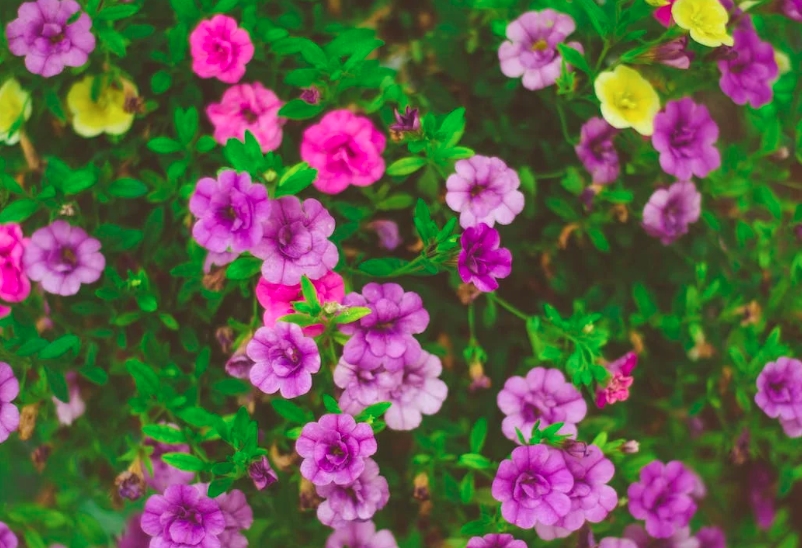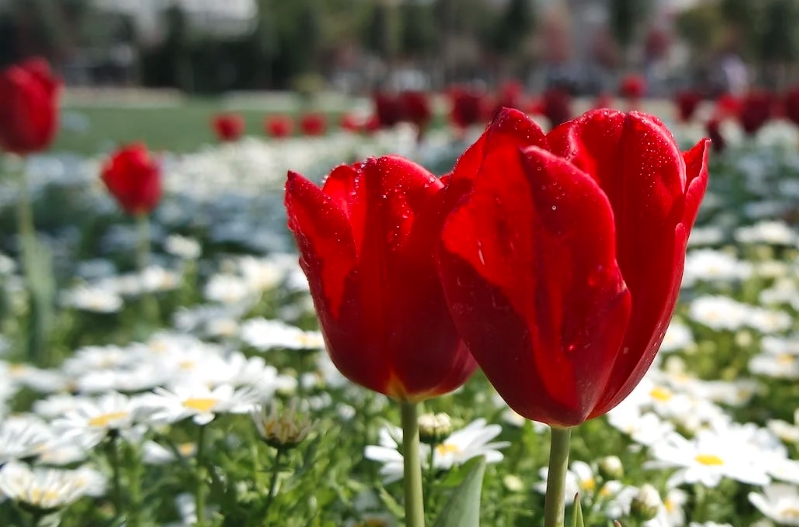Flower gardening is a wonderful activity, both for the individual and for the environment. Not only does it provide beauty and pleasure, but it also helps to conserve natural resources, reduce pollution, and provide habitats for wildlife.
Flower gardening is a great way to bring beauty and color to your home and garden. From an individual point of view, it can be a great source of relaxation and enjoyment. It provides the opportunity to express creativity and can be a great way to connect with nature. It can also be an ideal way to spend time with family and friends.
Aside from the personal benefits, flower gardening can also contribute to the health of the environment. Gardens are great sources of oxygen and provide habitats for wildlife. The use of native plants helps to conserve natural resources, as they require less maintenance and fewer inputs, such as water and fertilizer. Additionally, the use of organic methods helps to reduce pollution and the release of harmful chemicals into the environment.
These are just a few of the benefits of flower gardening. With the right knowledge and tools, anyone can create a beautiful and sustainable garden. Bloomin’ Beautiful: A Guide to Flower Gardening is an excellent resource for those interested in learning the basics of flower gardening. It will provide you with the necessary information and tips to start and maintain a successful flower garden.

Choosing the Right Flowers for Your Garden
Choosing the right flowers for your garden can be a daunting task, but with the right information, you can ensure that your garden is filled with beautiful blooms that will last throughout the season. In this article, we will discuss the different types of flowers that are suitable for your garden based on factors such as soil type, climate, and sun exposure. We will also provide a list of some of the most popular flowers and their specific requirements.
Different Types of Flowers
1. Annuals: Annuals are flowers that will bloom throughout the season, but need to be replanted each year. They are usually very colorful and low maintenance. Some popular annuals include cosmos, marigold, petunias, and zinnias.
2. Perennials: Perennials are flowers that will come back each year if they are planted correctly. Some popular perennials include daylilies, daffodils, and daisies.
3. Bulbs: Bulbs are a great way to add color to your garden. They are easy to plant and will usually bloom in the spring. Some popular bulbs include tulips, lilies, and dahlias.
4. Vines: Vines are a great way to add some visual interest to your garden, as well as provide some privacy. Some popular vines include clematis, honeysuckle, and morning glory.
Factors to Consider When Choosing Flowers
1. Soil Type: Different types of plants require different types of soil. Some plants prefer sandy soil, while others prefer rich, loamy soil. Be sure to check the soil requirements for the flowers you are considering before planting them.
2. Climate: Different plants thrive in different climates. Be sure to check the hardiness zone of the flowers you are considering and choose ones that are suitable for your climate.
3. Sun Exposure: Different flowers require different amounts of sun. Some plants thrive in full sun, while others prefer partial shade. Make sure you check the sun requirements for the plants you are considering before planting them.
Popular Flowers and Their Requirements
The following is a list of some of the most popular flowers and their specific requirements: • Marigolds: Marigolds prefer full sun and well-drained soil.
• Petunias: Petunias prefer full sun and moist, well-drained soil.
• Zinnias: Zinnias prefer full sun and moist, well-drained soil.
• Daylilies: Daylilies prefer partial shade and well-drained soil.
• Daffodils: Daffodils prefer full sun and well-drained soil.
• Daisies: Daisies prefer full sun and well-drained soil.
• Tulips: Tulips prefer full sun and well-drained soil.
• Lilies: Lilies prefer partial shade and well-drained soil.
• Clematis: Clematis prefer full sun and moist, well-drained soil.
• Honeysuckle: Honeysuckle prefers full sun and moist, well-drained soil.
• Morning Glory: Morning Glory prefers full sun and well-drained soil.
Preparing Your Garden for Planting
Preparing Your Garden for Planting
1. Soil Testing – Testing the soil of your garden is the first step to prepare it for planting. This process will help you to determine the pH level and fertility of the soil. A soil test kit or a local laboratory can help you to do this.
2. Removing Weeds – Weeds can be a major problem for your garden. Before planting, make sure to remove all weeds from the soil. This will help to reduce the competition for water, light and nutrients. You can use a weeding tool to carefully remove any weeds from the soil.
3. Adding Compost or Fertilizer – Adding compost or fertilizer to the soil is also important to prepare your garden for planting. Compost will help to improve the quality of the soil and provide essential nutrients to your plants. Fertilizer will also help to provide the nutrients that the plants need to grow.
Designing Your Garden
1. Arranging the Flowers – Arranging the flowers in your garden is a very important step. Make sure to arrange the flowers in a way that will make them look aesthetically pleasing. You can also add some other elements to the garden such as pathways, benches, and other decorations.
2. Choosing the Right Plants – Choosing the right plants for your garden is also important. Make sure to choose plants that will thrive in your climate and soil. Research different plants and find out which ones would work best in your garden.
3. Maintenance –Maintaining your garden is also important. Make sure to water, fertilize, and prune your plants regularly to keep them healthy and happy.
Planting Your Flowers
Planting your own flowers is a great way to add beauty to your garden. There are a few steps to follow when planting your flowers, and following these steps will ensure that your flowers will thrive.
Step 1: Choose the Right Spot
The first step when planting your flowers is choosing the right spot. Ideally, the spot should have full sun or partial shade and be free of weeds. You should also consider the type of soil that your flowers need.
Step 2: Dig Holes
Once you’ve chosen the right spot, the next step is to dig holes for your flowers. The holes should be deep enough to accommodate the roots of your flowers, and you should allow for plenty of space between each flower.
Step 3: Plant the Flowers
When planting your flowers, make sure to loosen the soil around the roots before placing them in the hole. Make sure to pack the soil around the base of the plant and water it well.
Step 4: Water and Fertilize
After planting, be sure to water your flowers regularly. You should also add fertilizer to the soil to give your flowers the nutrients they need to thrive.
Step 5: Prune and Mulch
Prune your flowers regularly to keep them looking their best. Also, add a layer of mulch around the base of the plant to help retain moisture and keep weeds away.
By following these steps, your flowers will be sure to thrive and bring beauty to your garden. Planting your own flowers is a rewarding experience, and following these steps will ensure that your flowers will stay healthy and beautiful for years to come.
Caring for Your Flowers
Watering
A. How Often – Flowers typically require watering once every 1-2 days. The amount and frequency of watering depends on the climate and type of flowers.
B. Water Source – Tap water is generally recommended for watering flowers. If you have access to rainwater, you can also use it for watering your flowers, as it is usually free of chemicals.
C. Temperature – It is important to use lukewarm or room temperature water when watering your flowers. Water that is too cold may shock the roots and cause the flowers to wilt.
Fertilizing
A. Types of Fertilizers – There are many types of fertilizers available on the market, including organic and chemical fertilizers.
B. Application – Fertilizers should be applied every two weeks or as recommended by the manufacturer.
C. Timing – Fertilizers should be applied in the early morning or evening when the temperature is cooler.
Pruning
A. When to Prune – Pruning should be done in the spring or summer, when the flowers are actively growing.
B. Types of Pruning – There are two main types of pruning: deadheading, which involves removing dead or wilted blooms, and shaping, which involves trimming or cutting back stems or branches.
C. Deadheading – Deadheading can help encourage new blooms and keep the flowers looking healthy and attractive.
Pest Control
A. Identifying Pests – The most common pests to look out for are aphids, mealybugs, spider mites, and whiteflies.
B. Natural and Chemical Control – Natural pest control methods such as ladybugs, neem oil, and horticultural oil can help to get rid of pests without the use of harmful chemicals. Chemical pest control should be used as a last resort.
C. Prevention – Prevention is the best way to avoid pest issues. This can include regularly monitoring your plants and using insecticidal soap or neem oil to prevent infestations.
Soil Care
A. Soil Maintenance – Soil maintenance is essential for keeping flowers healthy. This includes regularly checking the soil for moisture and aeration, adding compost or other organic matter, and adjusting the pH level.
B. Composting – Composting can help to improve soil quality and provide essential nutrients for flowers. You can create your own compost pile or buy compost from a local garden center.
C. Aeration – Aeration helps to provide oxygen to the roots and improves drainage. This can be done by poking holes in the soil or using a garden fork to loosen the soil.
Disease Prevention
A. Proper Watering – Proper watering is key to preventing diseases in flowers. This includes watering at the base of the plant and avoiding overwatering.
B. Rotating Plants – Rotating plants can help to prevent diseases caused by soil-borne pathogens.
C. Dealing with Fungus – Fungus can also be a common problem with flowers. To prevent this, make sure to remove any dead or diseased flowers, and avoid wetting the foliage when watering.
Seasonal Maintenance
Seasonal maintenance is an essential part of keeping a household or business running smoothly. Different types of maintenance are needed throughout the year, depending on the season and the particular needs of the property. Winter preparation, spring cleaning, and summer maintenance are all important tasks that must be completed in order to ensure the property remains in good condition.
Winter Preparation
Preparing for the winter months is an important part of seasonal maintenance. This includes taking steps to protect the property from the elements, such as insulating pipes, clearing gutters, and covering windows. It is also important to winterize any outdoor equipment, such as lawnmowers and snow blowers, to ensure they are ready to use when the snow starts to fall. Homeowners should also check the roof and make sure it is in good condition before the snow starts to accumulate.
Spring Cleaning
Spring cleaning is an important part of the seasonal maintenance cycle. This includes cleaning windows, washing walls, scrubbing floors, and dusting furniture. It is also important to inspect the property for any damage that may have occurred over the winter months. Homeowners should check for leaks, cracks, and any other issues that may need to be addressed. Finally, it is important to make sure the yard is in good condition and the plants are healthy.
Summer Maintenance
Summer maintenance is also an important part of seasonal maintenance. This includes keeping the lawn in good condition, trimming trees and hedges, and checking for any signs of pests or disease. It is also important to check for any damage that may have occurred during the spring months. Homeowners should inspect the roof and make sure it is in good condition before the summer months. Finally, it is important to make sure outdoor equipment, such as lawnmowers and pool pumps, are in working order.

Common Flower Gardening Problems
Pests: Pests are one of the most common problems gardeners face when growing flowers. Common pests include aphids, slugs, and snails. These pests can damage plants, eating away at leaves and stems. Solutions to this problem include using natural remedies such as introducing beneficial insects such as ladybugs, or using a mixture of water and dish soap as a natural pesticide. It is also important to practice preventative measures such as removing dead leaves and other debris from the garden and staying vigilant for signs of pests.
Diseases: Diseases can also be a problem for flower gardens. Common diseases include powdery mildew and rust. These diseases can cause plant leaves to become discolored and distorted, and can stunt the growth of the plant. Solutions to this problem include avoiding overcrowding of plants, removing affected leaves, and using a fungicide. Regular monitoring of plants for signs of disease can also help in preventing it from spreading.
Poor Soil Quality: Poor soil quality can also be an issue for flower gardens. Poor soil can lead to nutrient deficiencies, making it difficult for plants to grow. Solutions to this problem include adding compost or other organic matter to the soil to improve its structure and increase nutrient content, as well as applying fertilizer. Regular soil tests can also be helpful in diagnosing and correcting soil issues.
Conclusion
The beauty of flower gardening is that it can be as simple or as complex as you want it to be. Whether you’re a beginner just starting out or a more experienced gardener looking to expand your horizons, Bloomin’ Beautiful: A Guide to Flower Gardening will help you understand the fundamentals of flower gardening and provide you with the tools and resources you need to create a stunning and vibrant flower garden. With the information and tips provided in this guide, you’ll be able to choose the right plants, determine the best soil and location for your garden, and understand how to properly care for your flowers. With patience, dedication, and a love of plants and flowers, you’ll have a beautiful garden that you can be proud of. After all, nothing beats the smell of fresh flowers in the summer air and the sight of a garden in bloom. So, let Bloomin’ Beautiful be your guide to creating a gorgeous flower garden of your own.
FAQs
1. What are the benefits of flower gardening?
Flower gardening offers many benefits including adding beauty to your outdoor space, providing fresh air and improving your mental health by providing a creative outlet. It can also be a great way to relax and reduce stress.
2. How do I start a flower garden?
Starting a flower garden can be easy if you plan ahead. First, decide what type of flowers you would like to grow and the location of your garden. Then, prepare the soil by removing weeds, adding organic matter, and tilling the soil. Next, select the varieties of flowers you want to plant and make sure they get enough sun and water. Finally, fertilize and mulch your garden to help keep your plants healthy.
3. What is the best soil for flower gardening?
The best soil for flower gardening is a well-drained, loamy soil with a pH between 6.0 and 7.0. It should also be amended with organic matter to help retain moisture and provide nutrients for the plants.
4. How often should I water my flower garden?
How often you water your flower garden depends on the type of flowers you are growing, the climate and the amount of rainfall. Generally, it’s a good idea to water your flowers deeply once or twice a week.
5. What is the best time to plant flowers?
The best time to plant flowers depends on the type of flower you are planting and your climate. Generally, spring is the best time to plant flowers, but you can also plant in late summer or early fall.
6. What kind of fertilizer should I use for my flower garden?
The best fertilizer for your flower garden depends on the type of flowers you are growing and the soil conditions. Generally, a balanced fertilizer such as 10-10-10 is a good choice. You may also want to use an organic fertilizer for a more natural option.
7. How can I prevent weeds in my flower garden?
The best way to prevent weeds in your flower garden is by using mulch around the plants. This will help to prevent weeds from taking root and will also help to retain moisture in the soil. You can also use an herbicide to help control weeds.
8. How do I keep my flower garden healthy?
Keeping your flower garden healthy requires proper care and maintenance. Make sure to water your plants regularly, fertilize as needed, and remove weeds. You should also deadhead spent blooms to promote new growth. Additionally, it’s important to keep your garden free of pests and diseases.
9. What are some easy-to-grow flowers?
Some easy-to-grow flowers include pansies, marigolds, daisies, petunias, and impatiens. These flowers are easy to care for and thrive in most climates.
10. What are some tips for growing flowers in containers?
When growing flowers in containers, it’s important to choose a pot that is the right size for the plants. The pot should be large enough to accommodate the root system of the plants. Additionally, use a potting soil specifically designed for container gardening and make sure to water your plants regularly. Finally, make sure the container is in a sunny spot and fertilize as needed.


















